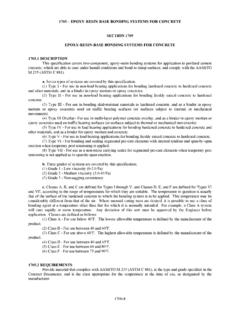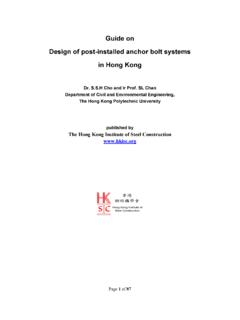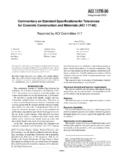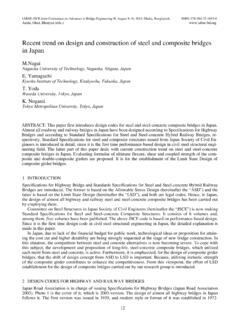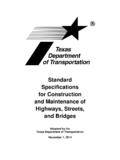Transcription of TOKYO INSTITUTE OF TECHNOLOGY - 東京工業大学
1 TOKYO INSTITUTE OF TECHNOLOGY DEPARTMENT OF CIVIL ENGINEERING ATCE-II ADVANCED TOPICS IN CIVIL ENGINEERING Second Semester 2005 Professor Kamran M. Nemati Temporary Structures CofferdamsCofferdamsCofferdamsCofferdams ATCE-II ADVANCED TOPICS IN CIVIL ENGINEERING Lesson 4: Cofferdams Overview A cofferdam is a temporary structure designed to keep water and/or soil out of the excavation in which a bridge pier or other structure is built. When construction must take place below the water level, a cofferdam is built to give workers a dry work environment. Sheet piling is driven around the work site, seal concrete is placed into the bottom to prevent water from seeping in from underneath the sheet piling, and the water is pumped out. The word "cofferdam" comes from "coffer" meaning box, in other words a dam in the shape of a box.
2 This lesson covers structural cofferdams as temporary installation, explaining in step-by-step detail proper and safe methods and materials to be used. There are different types of cofferdam, some are used to support excavation operation and some are enclosed type box placed in the water. The focus of this lesson is on the latter type. Lesson Objectives By the end of this lesson you will be able to: describe cofferdams and when they are used on construction projects; describe the forces on cofferdams explain design considerations; recognize the importance of sealing the bottom of cofferdams Reading Assignment Class notes Optional reading: Ratay, Chapter 7 "Cofferdams". ATCE-II TEMPORARY STRUCTURES LESSON 4: COFFERDAMS Page 1 of 13 1. INTRODUCTION Cofferdams are temporary enclosures to keep out water and soil so as to permit dewatering and construction of the permanent facility (structure) in the dry.
3 A cofferdam involves the interaction of the structure, soil, and water. The loads imposed include the hydrostatic forces of the water, as well as the dynamic forces due to currents and waves. In construction of cofferdams maintaining close tolerances is difficult since cofferdams are usually constructed offshore and sometimes under severe weather conditions. Under these circumstances, significant deformations of cofferdam elements may happen during the course of construction, and therefore it may be necessary to deviate from the design dimensions in order to complete the project according to plan. The loads imposed on the cofferdam structure by construction equipment and operations must be considered, both during installation of the cofferdam and during construction of the structure itself. Removal of the cofferdam must be planned and executed with the same degree of care as its installation, on a stage-by-stage basis.
4 The effect of the removal on the permanent structure must also be considered. For this reason, sheet piles extending below the permanent structure are often cut off and left in place, since their removal may damage the foundation soils adjacent to the structure. In cofferdam construction, safety is a paramount concern, since workers will be exposed to the hazard of flooding and collapse. Safety requires that every cofferdam and every part thereof shall be of suitable design and construction, of suitable and sound material and of sufficient strength and capacity for the purpose for which it is used, proper construction, verification that the structure is being constructed as planned, monitoring the behavior of the cofferdam and surrounding area, provision of adequate access, light and ventilation, and attention to safe practices on the part of all workers and supervisors, and shall be properly maintained.
5 Types of cofferdam: 1. Braced: It is formed from a single wall of sheet piling which is driven into the ground to form a box around the excavation site. The box is then braced on the inside and the interior is dewatered. It is primarily used for bridge piers in shallow water (30 - 35 ft depth) 2. Earth-Type: It is the simplest type of cofferdam. It consists of an earth bank with a clay core or vertical sheet piling enclosing the excavation. It is used for low-level waters with low velocity and easily scoured by water rising over the top. 3. Timber Crib: Constructed on land and floated into place. Lower portion of each cell is matched with contour of river bed. It uses rock ballast and soil to decrease seepage and sink into place, also known as Gravity Dam . It usually consists of 12 x12 cells and is used in rapid currents or on rocky river beds.
6 It must be properly designed to resist lateral forces such as tipping / overturning and sliding. 4. Double-Walled Sheet Pile: They are double wall cofferdams comprising two parallel rows of sheet piles driven into the ground and connected together by a system of tie rods at one or more levels. The space between the walls is generally filled with granular material such as sand, gravel or broken rock. ATCE-II TEMPORARY STRUCTURES LESSON 4: COFFERDAMS Page 2 of 13 5. Cellular: Cellular cofferdams are used only in those circumstances where the excavation size precludes the use of cross-excavation bracing. In this case, the cofferdam must be stable by virtue of its own resistance to lateral forces. Advantages of Cofferdam Performing work over water has always been more difficult and costly than performing the same work on land.
7 And when the work is performed below water, the difficulties and cost difference can increase geometrically with the depth at which the work is performed. The key to performing marine construction work efficiently is to minimize work over water, and perform as much of the work as possible on land. Below some of the advantages of cofferdams are listed: Allow excavation and construction of structures in otherwise poor environment Provides safe environment to work Contractors typically have design responsibility Steel sheet piles are easily installed and removed Materials can typically be reused on other projects Installation The success of any piling scheme requires satisfactory completion of the following stages. 1. Competent site investigation, sampling and relevant testing to build up an informed picture of the task.
8 2. Adequate design of all the stages of the construction. 3. Setting out and installation of the piles. As with all site operations the relevant legislation and guidance on matters pertaining to safety must be strictly adhered to. Items needed for installation are pile driving hammer (vibratory or impact), crane of sufficient size, steel sheet piles are typically used, H-piles and/or wide-flange beams for wales and stringers. In many cases barges may be required for efficient installation of cofferdams. 2. TYPES OF IMPOSED LOADS A typical cofferdam will experience several loading conditions as it is being build and during the various construction stages. The significant forces are hydrostatic pressure, forces due to soil loads, water current forces, wave forces, ice forces, seismic loads and accidental loads. In order to over come the displaced water buoyancy, the tremie seal thickness is about equal to the dewatered depth.
9 Figure below shows a typical cofferdam schematic. ATCE-II TEMPORARY STRUCTURES LESSON 4: COFFERDAMS Page 3 of 13 Figure 0 Typical cofferdam schematic Hydrostatic pressure The maximum probable height outside the cofferdam during construction and the water height inside the cofferdam during various stages of construction need to be considered. These result in the net design pressure shown in Fig. 1 below: Figure 1 - Hydrostatic forces on partially dewatered cofferdam ATCE-II TEMPORARY STRUCTURES LESSON 4: COFFERDAMS Page 4 of 13 Forces due to Soil Loads The soils impose forces, both locally on the wall of the cofferdam and globally upon the structure as a whole. These forces are additive to the hydrostatic forces. Local forces are a major component of the lateral force on sheet-pile walls, causing bending in the sheets, bending in the wales, and axial compression in the struts (see Fig.)
10 2). Figure 2 - Soil force in typical weak muds or clays Current Forces on Structure With a typical cofferdam, the current force consists not only the force acting on the normal projection of the cofferdam but also on the drag force acting along the sides. With flat sheet piles, the latter may be relatively small, whereas with z-piles it may be substantial, since the current will be forming eddies behind each indentation of profile, as shown in Fig. 3. Figure 3 Current flow along sheet piles Wave forces Waves acting on a cofferdam are usually the result of local winds acting over a restricted fetch and hence are of short wavelength and limited to height. However, in some cases the cofferdam should have at least three feet of freeboard or higher above the design high water elevation than the maximum expected wave height.
